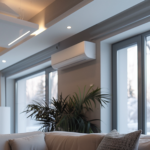Ensuring Code Compliance for Photovoltaic Systems
With the increasing adoption of renewable energy in residential construction, photovoltaic (PV) systems are becoming a common feature on homes. These systems can help homeowners reduce energy costs, enhance property value, and support sustainability goals. However, proper installation and adherence to relevant codes are crucial to ensure safety, efficiency, and durability.
This blog provides detailed, code-compliant information for photovoltaic system installations, including rooftop and ground-mounted systems. It highlights key aspects for plan review, field inspections, and best practices to ensure compliance with the 2015 International Residential Code (IRC), 2015 International Energy Conservation Code (IECC), and National Electric Code (NEC). Adhering to these guidelines ensures smooth plan approvals, streamlined inspections, and safe operation.
Why Code Compliance Matters for Photovoltaic Systems
PV systems involve multiple components—solar panels, inverters, electrical wiring, mounting hardware, and safety controls. Improper design or installation can result in:
- Electrical hazards, including fire risks or system failures.
- Structural issues, such as roof damage from improper mounting.
- Reduced efficiency due to poor orientation or shading.
By following established codes and guidelines, builders, contractors, and code officials can minimize these risks while ensuring the system operates efficiently and safely.
Plan Review Checklist for Photovoltaic Systems
General Code Requirements
Per 2015 IRC Section R104 and 2015 IECC Section R103, construction documents must be reviewed and approved by a building official before installation begins. Key items to include in the documentation are:
- System Design and Layout
- Specify the type of PV system (grid-tied, off-grid, or hybrid).
- Indicate panel size, quantity, and layout on the roof or ground.
- Ensure adequate spacing for roof access and emergency pathways as per IRC Section R324.6.
- Equipment Ratings and Testing
- Ensure all panels, inverters, and mounting systems are listed and labeled according to UL standards:
- UL 1703 or UL 61730-1 and UL 61730-2 for PV panels and modules.
- UL 1741 for inverters.
- UL 2703 for mounting systems.
- Ensure all panels, inverters, and mounting systems are listed and labeled according to UL standards:
- Electrical Design
- Provide a detailed electrical layout, including conduit runs, wiring specifications, and grounding methods in accordance with NEC Article 690.
- Ensure compliance with utility interconnection requirements for grid-tied systems.
- Structural Considerations
- Verify that the roof structure can support the additional load of the PV system.
- Roof-mounted systems must meet wind and snow load requirements per IRC Section R324.4.1.
- Ground-mounted systems must have proper footing and anchoring as per IRC Section R324.7.
- Fire Safety
- Include fire classification ratings for rooftop-mounted PV systems. Systems must have a fire rating equal to or better than the roof covering, per IRC Section R324.4.2.
- Ensure roof penetrations are flashed and sealed to maintain weather tightness and fire resistance.
Field Inspection Guidelines for Photovoltaic Systems
Structural Inspection
- Rooftop Systems
- Verify that the panels and mounting hardware are securely attached per the manufacturer’s instructions.
- Ensure roof penetrations are properly sealed to prevent leaks.
- Confirm that the installed system does not compromise the structural integrity of the roof.
- Ground-Mounted Systems
- Confirm that the mounting structure is properly anchored and level.
- Verify compliance with setback and height requirements outlined in the approved plans.
H3: Electrical Inspection
- Panels and Wiring
- Ensure that the PV panels are properly installed, with all wiring secured and protected.
- Verify that wiring and conduit installations comply with NEC Article 690 and are free from damage or exposure.
- Inverter Installation
- Confirm that the inverter is listed and labeled per UL 1741 and installed in a well-ventilated location.
- Ensure proper grounding and bonding of the system.
- Labeling and Safety Signage
- Check that all required safety labels and signage are installed, including:
- Labels on disconnects and junction boxes indicating “Photovoltaic Power Source.”
- Main service panel labels indicating the presence of a back-fed PV system.
- Check that all required safety labels and signage are installed, including:
- Disconnects and Shutoff
- Ensure that an accessible, lockable AC/DC disconnect switch is installed, per NEC and local utility requirements.
Best Practices for Photovoltaic System Installation
- Site Selection and Shading Analysis
- Perform a shading analysis to ensure maximum sunlight exposure.
- Ensure the system is oriented to maximize solar gain based on geographic location.
- Weatherproofing
- Use flashing kits specifically designed for solar installations to prevent water intrusion.
- Energy Storage Compatibility
- If future energy storage is planned, ensure the system design allows for easy integration of batteries.
- Utility Coordination
- Coordinate with the local utility early in the process for interconnection requirements and inspections.
Compliance with Solar Energy Ready Programs
Homes participating in programs like the U.S. Department of Energy Zero Energy Ready Home must be designed as “solar-ready.” This involves designating a solar zone on the roof, ensuring proper electrical conduit routing, and maintaining a penetration-free, shade-free area for future PV system installation.
Conclusion
Proper installation of photovoltaic systems is essential to ensure safety, efficiency, and long-term performance. By adhering to IRC, IECC, and NEC codes, as well as best practices for mounting, wiring, and fire safety, homeowners can enjoy the full benefits of solar energy while minimizing risks. For builders, designers, and contractors, ensuring compliance from the plan review stage through field inspection is key to successful installations.
For immediate service or consultation, contact Allied Emergency Services, INC.
Contact Information:
- Phone: 1-800-792-0212
- Email: Info@AlliedEmergencyServices.com
- Location: Serving Illinois, Wisconsin, and Indiana with a focus on the greater Chicago area.
Disclaimer: This article is intended for informational purposes only. For professional advice, consult experts in the field.










